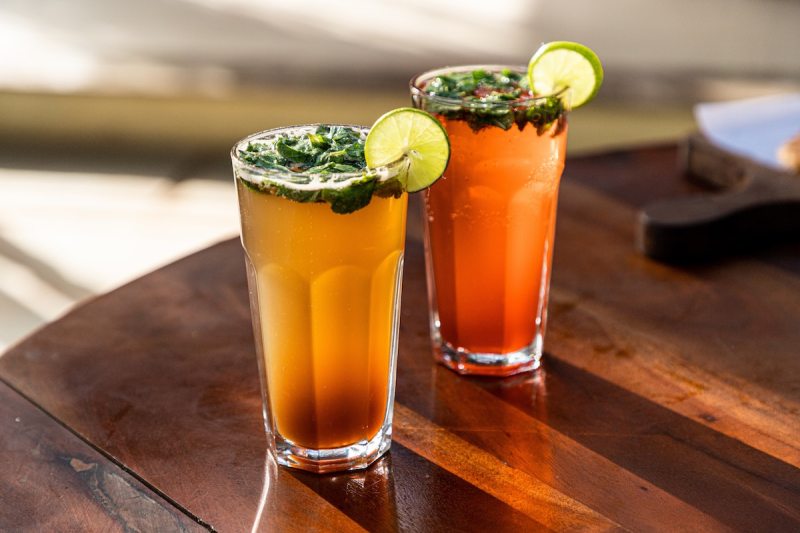A new year is upon us and for a lot of people, that means new healthy habits. It might mean a new diet, pre-bedtime sleep ritual, or cutting back on the booze. Often, the plusses of these lifestyle changes are so significant that you hope to continue them well beyond just January.
There are lots of sober curious people looking to take the merits of Dry January all the way through 2023. But it’s not easy, especially with our favorite bars back open, friends always looking for an excuse to get out, and some really good cocktails in the mix. So we solicited some advice from drinks industry pros who’ve done the Dry January thing and learned from it. Here’s some of that valuable wisdom, passed on to the new, 2023 version of you.

Distracting Mocktails
Julia Momosé runs Kumiko in Chicago. She got through Dry January by way of drinks that involved a little thought and distraction. And it worked, as she’s now happily on to Dry February.
“At home, I always stock up on mocktail ingredients so that I’m not just reaching for something easy when I want to have a drink, like a bottle of wine,” she says. “In addition to various syrups like simple syrup, honey syrup, and tea syrup, I always keep mixers around, like spicy ginger beer, tonics, soda water, and Suntory ALL-FREE beer alternative.”
She especially likes the beer in a mocktail she’s developed, one that’s proven popular at the restaurant. She calls it the Garnet Shandy and relied on it to get her through the tougher moments of January. “It’s a simple mix of winter citrus-like satsuma, cranberry juice, and Suntory,” she says.
Strength in Numbers
A big reason people engage in Dry January is that they know many others will too. That strength in numbers is real and offers a big lift to many on the fence. According to Forbes, nearly a quarter of drinkers pledged to abstain the first month of this year, a percentage that continues to tick up every year. For those who can’t ride the popular wave or simply aren’t aware of it, create your own. Even if you’re just looking to consume less beer or take a few nights off per week, doing so as a team is easier. Buddy up with a friend, sibling, or significant other and create a routine that’s manageable and encourage each other to see it through.
Reinvent Happy Hour
We all deserve a 5 o’clock ritual that takes the sting out of the day. Sometimes, that can mean a refreshing Cold IPA. Other times, it can involve a zero-proof treat. It’s the ritual that makes it, not necessarily what’s in the glass. In fact, it doesn’t even have to be a beverage. A post-work jog, stroll, bike ride, or hike are all fair game and can be just as social (if that’s what you’re after) and stress relieving. It’s about what makes you happy, which doesn’t necessarily mean a heaping glass or two of a depressant. People are treating happy hour as more of a state of mind than watering hole tradition and rightly so.
Make a Meal of It
Dane Lewandowski is the US Territory Manager for Big Drop Brewing, a UK-based NA (non-alcoholic) beer brand. He saw great success in pairing events in Chicago that aligned non-alcoholic beer with complementary bites like burgers or a slice of pizza. “We’ll do more of these activations throughout 2022 and go even bigger for Dry January 2023,” he says.
Lewandowski also notes that there’s a general crossover that’s become more typical. Now that we’re treating NA beer more seriously, the quality is increasing markedly. Beer nerds who are devout about hop types and style specifics are willing to try a zero-proof option and, increasingly, go back for more. “Full-strength craft beer lovers are exploring some of the new craft NA beer options,” he says. “Josh Noel, beer writer for the Chicago Tribune, tried Dry January this year and after sampling over 40 NA beers, he named Big Drop Paradiso IPA in one of his mixed six-pack picks.”
There’s Never Been a Better Time
With the zero-proof trend stronger than ever, there’s never been a better time to do a proper Dry January and even have it carry over beyond that. More and more alcohol-free wines, beers, and RTD mocktails are coming online, affording the consumer a plethora of flavors, styles, and directions. And that’s just the drinks made to resemble hard
The culture around dryness has not only been embraced but is now woven into the way we run our eating and drinking establishments. There really has never been a better time for such a thing.


